Healthcare Report: Risk Factors for Infection in Chronic Leg Ulcers
VerifiedAdded on 2022/10/19
|10
|2147
|31
Report
AI Summary
This report critically appraises research on chronic wounds, particularly focusing on leg ulcers and the risk factors associated with infection. The report begins with an abstract and introduction that highlights the importance of chronic wound management in healthcare, defining chronic wounds and explaining their complexity. A clinical question using the PICO format is developed to guide the literature search. The methodology section details the search strategy, databases used (CINAHL, Google Scholar), search terms, and inclusion/exclusion criteria. The chosen article, "Risk factors for infection in patients with chronic leg ulcers: A survival analysis," is analyzed. The study design, setting, participants, intervention, outcomes, prognostic factors, follow-up period, and main results are thoroughly examined. Key findings include the validation of predictive factors like depression, use of walking aids, calf ankle circumference ratio, and the presence of slough tissue, all of which are significantly associated with chronic leg infection. The report concludes by emphasizing the need for improved communication between nurses and healthcare professionals for effective patient care. References are provided.
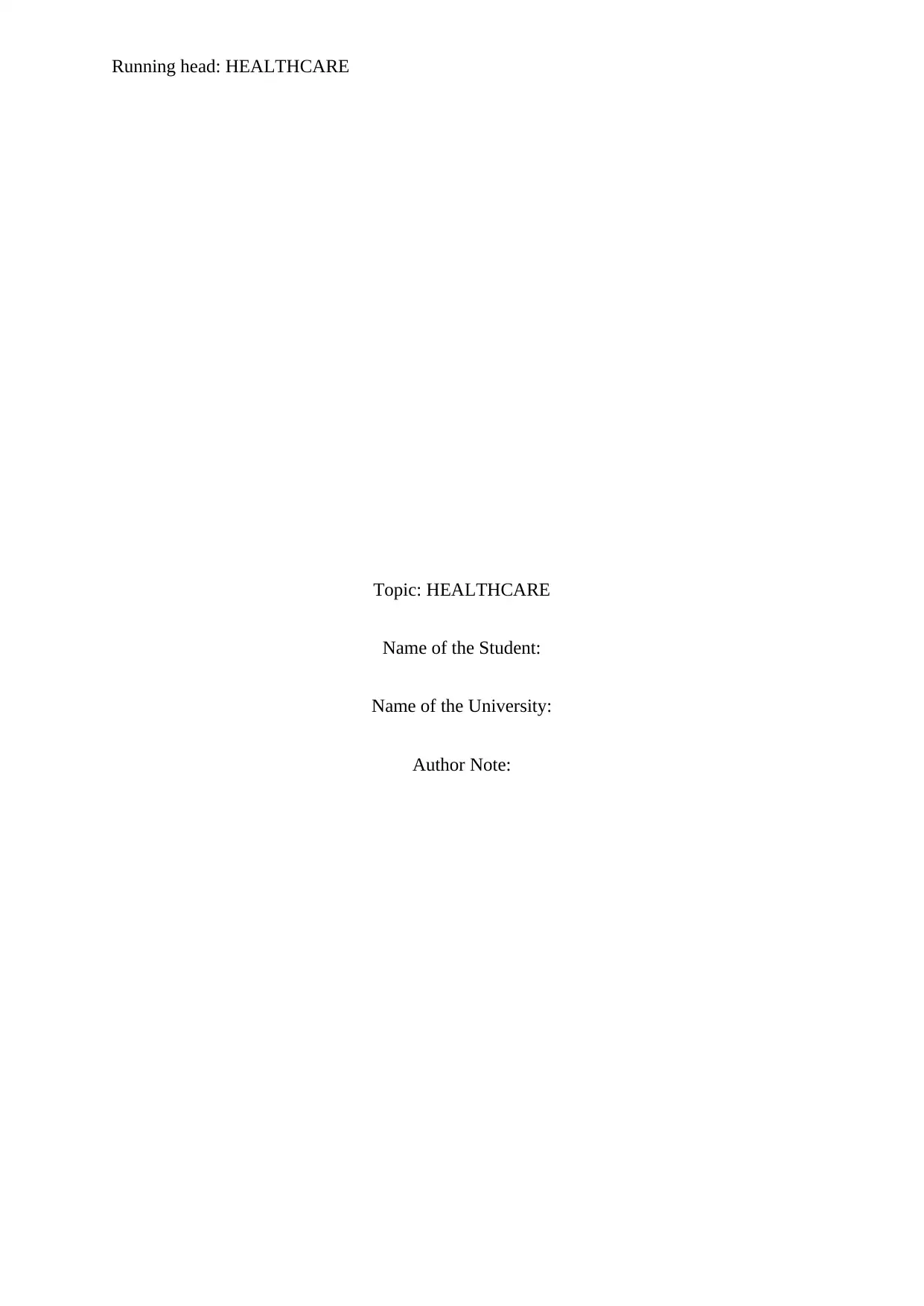
Running head: HEALTHCARE
Topic: HEALTHCARE
Name of the Student:
Name of the University:
Author Note:
Topic: HEALTHCARE
Name of the Student:
Name of the University:
Author Note:
Paraphrase This Document
Need a fresh take? Get an instant paraphrase of this document with our AI Paraphraser

1HEALTHCARE
Abstract
Over the years chronic wounds have become an important consideration in the medical
world. Chronic wound infection has been considered as a pivotal part of infection inpatients
as it has constituted 3 % of the patients in the emergency department. Infection has been
mainly considered as the main factor for wound complications and delayed healing. In the
given essay, the critical appraisal of articles revolving around the topic of chronic wounds
among people suffering from ulcers in the leg are considered after the consideration and
implementation of proper search strategy.
Abstract
Over the years chronic wounds have become an important consideration in the medical
world. Chronic wound infection has been considered as a pivotal part of infection inpatients
as it has constituted 3 % of the patients in the emergency department. Infection has been
mainly considered as the main factor for wound complications and delayed healing. In the
given essay, the critical appraisal of articles revolving around the topic of chronic wounds
among people suffering from ulcers in the leg are considered after the consideration and
implementation of proper search strategy.

2HEALTHCARE
Introduction
Over the years due to the high technological advancement both in the medical and the
healthcare sector, the nursing of chronic wounds have become a pivotal area of study (Bui,
Finalyson & Edwards, 2018). According to the definition of medical science a chronic would
is one which actually do not heal in a particular set of stages also within a particular amount
of time like other normal wounds (Guest et al., 2014 ). Chronic wounds are usually detained
among more than one of the pivotal phases of healing of wounds (Frykberg & Banks, 2015).
It is a complex as well as a highly regulated process which is usually important for the
maintenance of the barriers of the skin (Brynt & Nix, 2015). Along with eventual progression
of the diseases, there various processes which result inn non healing wounds which could
subject the patient to significant amounts of discomfort along distress because it leads to a
draining of a huge number of sources in the medical system (Kranke et al., 2015). This might
lead to pressure ulcers, leg ulcers along with dehisced wounds (Woo, 2015). In this following
essay there would be a critical appraisal of the articles chosen for the management and
exploration of chronic wounds as a important barrier to the implementation process involving
effective management of chronic wounds (Jrabrink et al., 2016).
Clinical question developed to find the article using the PICO format –
The PICOT analysis of the given clinical question is
P – Adult patients with chronic leg ulcers
I - Validation of possible predictive factors and clinical diagnosis in patients.
C- Comparison between people suffering from chronic leg ulcers and those patients not
suffer from ulcers.
O –Validation of the predictive ability of factors for the adult population
Introduction
Over the years due to the high technological advancement both in the medical and the
healthcare sector, the nursing of chronic wounds have become a pivotal area of study (Bui,
Finalyson & Edwards, 2018). According to the definition of medical science a chronic would
is one which actually do not heal in a particular set of stages also within a particular amount
of time like other normal wounds (Guest et al., 2014 ). Chronic wounds are usually detained
among more than one of the pivotal phases of healing of wounds (Frykberg & Banks, 2015).
It is a complex as well as a highly regulated process which is usually important for the
maintenance of the barriers of the skin (Brynt & Nix, 2015). Along with eventual progression
of the diseases, there various processes which result inn non healing wounds which could
subject the patient to significant amounts of discomfort along distress because it leads to a
draining of a huge number of sources in the medical system (Kranke et al., 2015). This might
lead to pressure ulcers, leg ulcers along with dehisced wounds (Woo, 2015). In this following
essay there would be a critical appraisal of the articles chosen for the management and
exploration of chronic wounds as a important barrier to the implementation process involving
effective management of chronic wounds (Jrabrink et al., 2016).
Clinical question developed to find the article using the PICO format –
The PICOT analysis of the given clinical question is
P – Adult patients with chronic leg ulcers
I - Validation of possible predictive factors and clinical diagnosis in patients.
C- Comparison between people suffering from chronic leg ulcers and those patients not
suffer from ulcers.
O –Validation of the predictive ability of factors for the adult population
⊘ This is a preview!⊘
Do you want full access?
Subscribe today to unlock all pages.

Trusted by 1+ million students worldwide
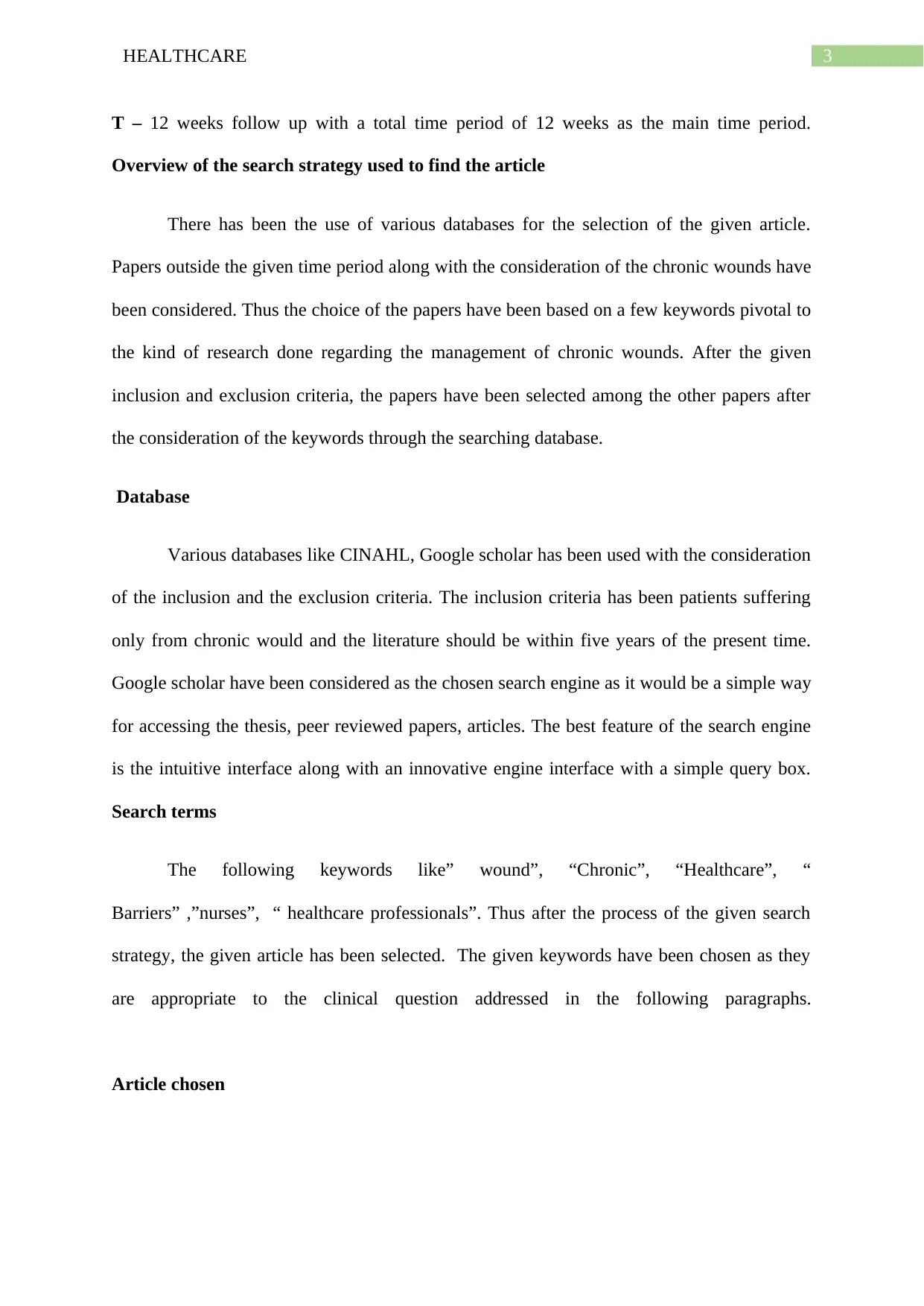
3HEALTHCARE
T – 12 weeks follow up with a total time period of 12 weeks as the main time period.
Overview of the search strategy used to find the article
There has been the use of various databases for the selection of the given article.
Papers outside the given time period along with the consideration of the chronic wounds have
been considered. Thus the choice of the papers have been based on a few keywords pivotal to
the kind of research done regarding the management of chronic wounds. After the given
inclusion and exclusion criteria, the papers have been selected among the other papers after
the consideration of the keywords through the searching database.
Database
Various databases like CINAHL, Google scholar has been used with the consideration
of the inclusion and the exclusion criteria. The inclusion criteria has been patients suffering
only from chronic would and the literature should be within five years of the present time.
Google scholar have been considered as the chosen search engine as it would be a simple way
for accessing the thesis, peer reviewed papers, articles. The best feature of the search engine
is the intuitive interface along with an innovative engine interface with a simple query box.
Search terms
The following keywords like” wound”, “Chronic”, “Healthcare”, “
Barriers” ,”nurses”, “ healthcare professionals”. Thus after the process of the given search
strategy, the given article has been selected. The given keywords have been chosen as they
are appropriate to the clinical question addressed in the following paragraphs.
Article chosen
T – 12 weeks follow up with a total time period of 12 weeks as the main time period.
Overview of the search strategy used to find the article
There has been the use of various databases for the selection of the given article.
Papers outside the given time period along with the consideration of the chronic wounds have
been considered. Thus the choice of the papers have been based on a few keywords pivotal to
the kind of research done regarding the management of chronic wounds. After the given
inclusion and exclusion criteria, the papers have been selected among the other papers after
the consideration of the keywords through the searching database.
Database
Various databases like CINAHL, Google scholar has been used with the consideration
of the inclusion and the exclusion criteria. The inclusion criteria has been patients suffering
only from chronic would and the literature should be within five years of the present time.
Google scholar have been considered as the chosen search engine as it would be a simple way
for accessing the thesis, peer reviewed papers, articles. The best feature of the search engine
is the intuitive interface along with an innovative engine interface with a simple query box.
Search terms
The following keywords like” wound”, “Chronic”, “Healthcare”, “
Barriers” ,”nurses”, “ healthcare professionals”. Thus after the process of the given search
strategy, the given article has been selected. The given keywords have been chosen as they
are appropriate to the clinical question addressed in the following paragraphs.
Article chosen
Paraphrase This Document
Need a fresh take? Get an instant paraphrase of this document with our AI Paraphraser
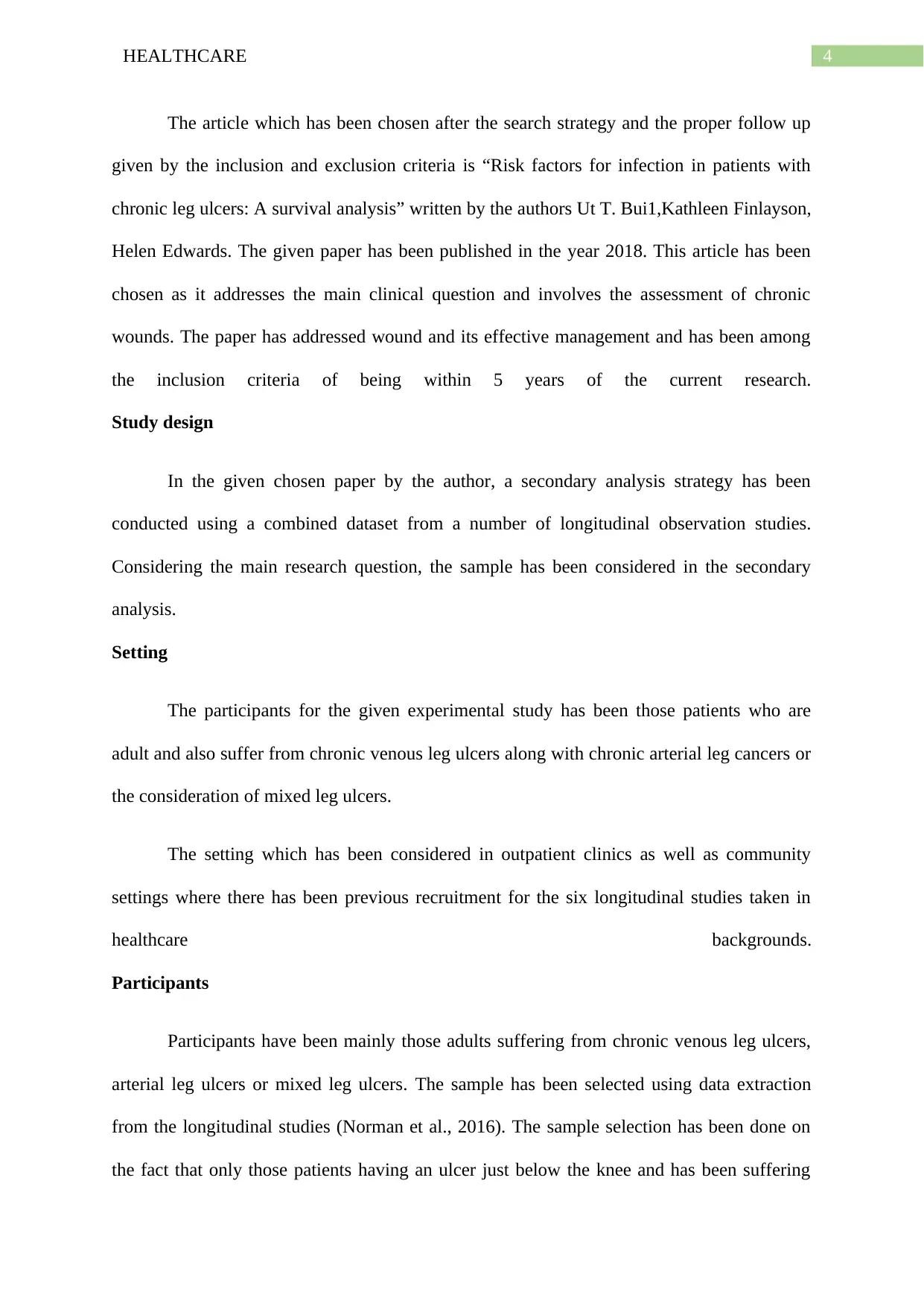
4HEALTHCARE
The article which has been chosen after the search strategy and the proper follow up
given by the inclusion and exclusion criteria is “Risk factors for infection in patients with
chronic leg ulcers: A survival analysis” written by the authors Ut T. Bui1,Kathleen Finlayson,
Helen Edwards. The given paper has been published in the year 2018. This article has been
chosen as it addresses the main clinical question and involves the assessment of chronic
wounds. The paper has addressed wound and its effective management and has been among
the inclusion criteria of being within 5 years of the current research.
Study design
In the given chosen paper by the author, a secondary analysis strategy has been
conducted using a combined dataset from a number of longitudinal observation studies.
Considering the main research question, the sample has been considered in the secondary
analysis.
Setting
The participants for the given experimental study has been those patients who are
adult and also suffer from chronic venous leg ulcers along with chronic arterial leg cancers or
the consideration of mixed leg ulcers.
The setting which has been considered in outpatient clinics as well as community
settings where there has been previous recruitment for the six longitudinal studies taken in
healthcare backgrounds.
Participants
Participants have been mainly those adults suffering from chronic venous leg ulcers,
arterial leg ulcers or mixed leg ulcers. The sample has been selected using data extraction
from the longitudinal studies (Norman et al., 2016). The sample selection has been done on
the fact that only those patients having an ulcer just below the knee and has been suffering
The article which has been chosen after the search strategy and the proper follow up
given by the inclusion and exclusion criteria is “Risk factors for infection in patients with
chronic leg ulcers: A survival analysis” written by the authors Ut T. Bui1,Kathleen Finlayson,
Helen Edwards. The given paper has been published in the year 2018. This article has been
chosen as it addresses the main clinical question and involves the assessment of chronic
wounds. The paper has addressed wound and its effective management and has been among
the inclusion criteria of being within 5 years of the current research.
Study design
In the given chosen paper by the author, a secondary analysis strategy has been
conducted using a combined dataset from a number of longitudinal observation studies.
Considering the main research question, the sample has been considered in the secondary
analysis.
Setting
The participants for the given experimental study has been those patients who are
adult and also suffer from chronic venous leg ulcers along with chronic arterial leg cancers or
the consideration of mixed leg ulcers.
The setting which has been considered in outpatient clinics as well as community
settings where there has been previous recruitment for the six longitudinal studies taken in
healthcare backgrounds.
Participants
Participants have been mainly those adults suffering from chronic venous leg ulcers,
arterial leg ulcers or mixed leg ulcers. The sample has been selected using data extraction
from the longitudinal studies (Norman et al., 2016). The sample selection has been done on
the fact that only those patients having an ulcer just below the knee and has been suffering

5HEALTHCARE
from the ulcer for a time interval f more than 4 weeks have been considered. Moreover
factors like people residing in the given community, being fluent in English and attending
community based clinics have been considered in the study.
Intervention or description of test
Patients who were considered for the study included the assessments for their ulcer
and surrounding characteristics of the tissue. Moreover, their ulcer infection status along with
clinical signs of infection were considered. Diagnosis of the infection was done on the basis
of clinical experience along with expertise in wound care.
Outcomes or diagnostic standard –
There has been an early diagnosis of the patients who have been at risk of the
development of infection among chronic wounds which leads to the timely as well as
appropriate management. There have been improved patients outcomes along with
minimized infection related costs involved in wound care. In relations with the pervious cross
section based studies it has been seen that that the calf ankle ratio, ulcer ratio along with ulcer
has been the risk factors which has been associated with the clinically diagnosed patients
among venous, arterial mixed leg ulcers.
Prognostic factors studied
The studies about the prognosis of the patients and their effective treatment has been
found that there is a high risk of diseases development which is used for the information of
patients along with their reduced chances of treatment (Mahoney, 2014). The prognosis of the
studies explores the importance of a collaborative approach between the patients and the
health care professionals for effective management of patients with chronic wounds. This
prognosis suggests communication channels among all the involved healthcare professionals
from the ulcer for a time interval f more than 4 weeks have been considered. Moreover
factors like people residing in the given community, being fluent in English and attending
community based clinics have been considered in the study.
Intervention or description of test
Patients who were considered for the study included the assessments for their ulcer
and surrounding characteristics of the tissue. Moreover, their ulcer infection status along with
clinical signs of infection were considered. Diagnosis of the infection was done on the basis
of clinical experience along with expertise in wound care.
Outcomes or diagnostic standard –
There has been an early diagnosis of the patients who have been at risk of the
development of infection among chronic wounds which leads to the timely as well as
appropriate management. There have been improved patients outcomes along with
minimized infection related costs involved in wound care. In relations with the pervious cross
section based studies it has been seen that that the calf ankle ratio, ulcer ratio along with ulcer
has been the risk factors which has been associated with the clinically diagnosed patients
among venous, arterial mixed leg ulcers.
Prognostic factors studied
The studies about the prognosis of the patients and their effective treatment has been
found that there is a high risk of diseases development which is used for the information of
patients along with their reduced chances of treatment (Mahoney, 2014). The prognosis of the
studies explores the importance of a collaborative approach between the patients and the
health care professionals for effective management of patients with chronic wounds. This
prognosis suggests communication channels among all the involved healthcare professionals
⊘ This is a preview!⊘
Do you want full access?
Subscribe today to unlock all pages.

Trusted by 1+ million students worldwide
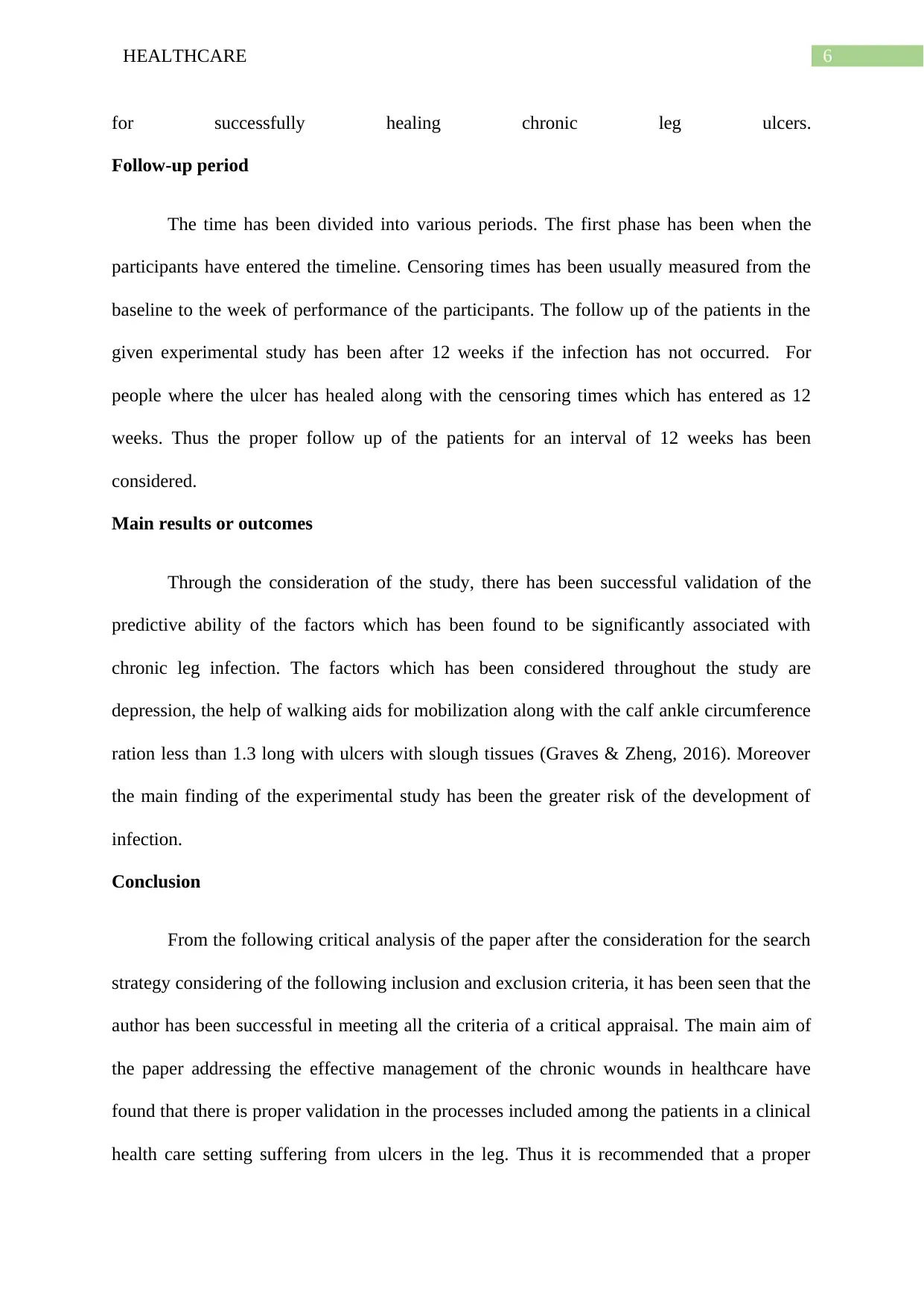
6HEALTHCARE
for successfully healing chronic leg ulcers.
Follow-up period
The time has been divided into various periods. The first phase has been when the
participants have entered the timeline. Censoring times has been usually measured from the
baseline to the week of performance of the participants. The follow up of the patients in the
given experimental study has been after 12 weeks if the infection has not occurred. For
people where the ulcer has healed along with the censoring times which has entered as 12
weeks. Thus the proper follow up of the patients for an interval of 12 weeks has been
considered.
Main results or outcomes
Through the consideration of the study, there has been successful validation of the
predictive ability of the factors which has been found to be significantly associated with
chronic leg infection. The factors which has been considered throughout the study are
depression, the help of walking aids for mobilization along with the calf ankle circumference
ration less than 1.3 long with ulcers with slough tissues (Graves & Zheng, 2016). Moreover
the main finding of the experimental study has been the greater risk of the development of
infection.
Conclusion
From the following critical analysis of the paper after the consideration for the search
strategy considering of the following inclusion and exclusion criteria, it has been seen that the
author has been successful in meeting all the criteria of a critical appraisal. The main aim of
the paper addressing the effective management of the chronic wounds in healthcare have
found that there is proper validation in the processes included among the patients in a clinical
health care setting suffering from ulcers in the leg. Thus it is recommended that a proper
for successfully healing chronic leg ulcers.
Follow-up period
The time has been divided into various periods. The first phase has been when the
participants have entered the timeline. Censoring times has been usually measured from the
baseline to the week of performance of the participants. The follow up of the patients in the
given experimental study has been after 12 weeks if the infection has not occurred. For
people where the ulcer has healed along with the censoring times which has entered as 12
weeks. Thus the proper follow up of the patients for an interval of 12 weeks has been
considered.
Main results or outcomes
Through the consideration of the study, there has been successful validation of the
predictive ability of the factors which has been found to be significantly associated with
chronic leg infection. The factors which has been considered throughout the study are
depression, the help of walking aids for mobilization along with the calf ankle circumference
ration less than 1.3 long with ulcers with slough tissues (Graves & Zheng, 2016). Moreover
the main finding of the experimental study has been the greater risk of the development of
infection.
Conclusion
From the following critical analysis of the paper after the consideration for the search
strategy considering of the following inclusion and exclusion criteria, it has been seen that the
author has been successful in meeting all the criteria of a critical appraisal. The main aim of
the paper addressing the effective management of the chronic wounds in healthcare have
found that there is proper validation in the processes included among the patients in a clinical
health care setting suffering from ulcers in the leg. Thus it is recommended that a proper
Paraphrase This Document
Need a fresh take? Get an instant paraphrase of this document with our AI Paraphraser
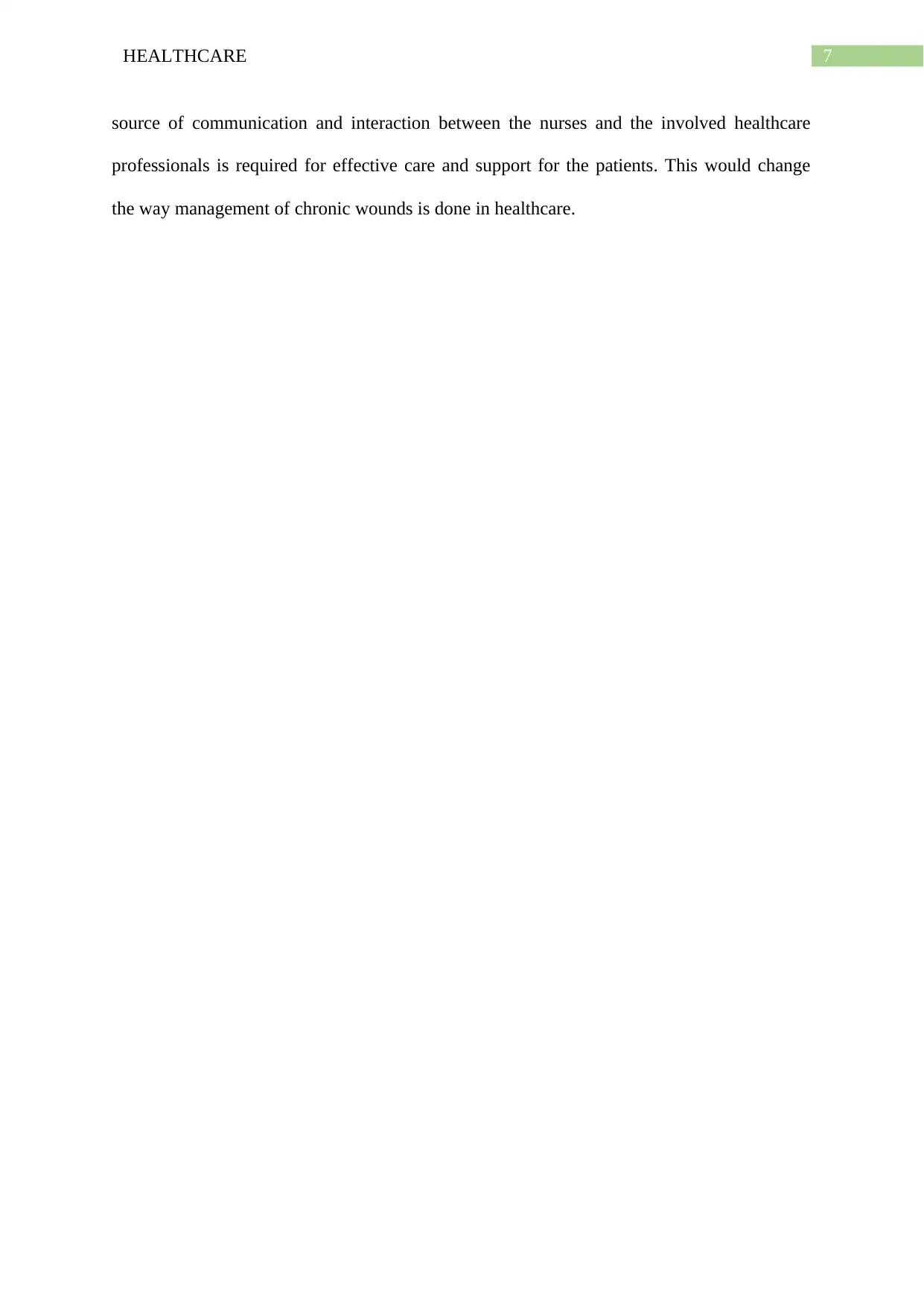
7HEALTHCARE
source of communication and interaction between the nurses and the involved healthcare
professionals is required for effective care and support for the patients. This would change
the way management of chronic wounds is done in healthcare.
source of communication and interaction between the nurses and the involved healthcare
professionals is required for effective care and support for the patients. This would change
the way management of chronic wounds is done in healthcare.
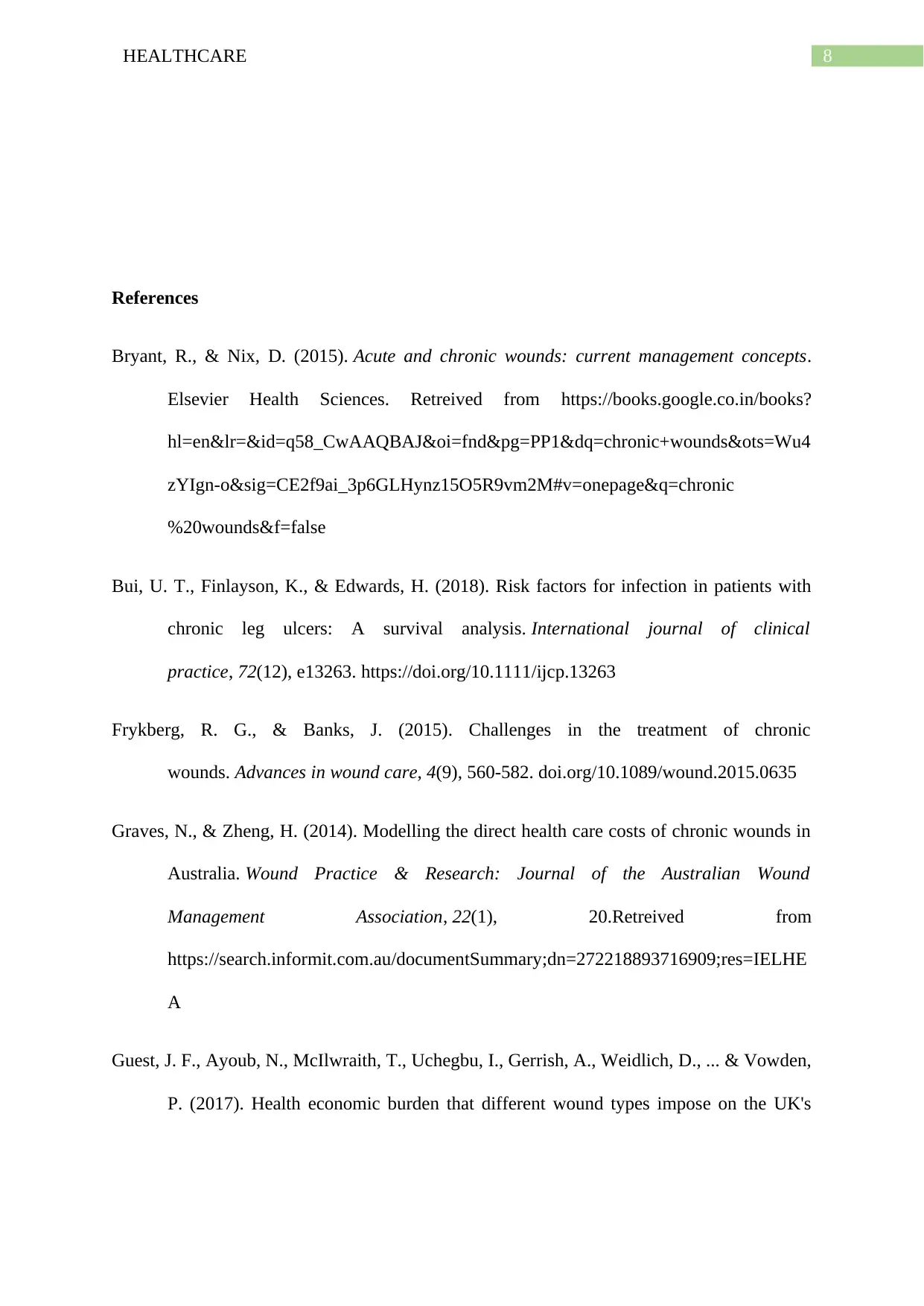
8HEALTHCARE
References
Bryant, R., & Nix, D. (2015). Acute and chronic wounds: current management concepts.
Elsevier Health Sciences. Retreived from https://books.google.co.in/books?
hl=en&lr=&id=q58_CwAAQBAJ&oi=fnd&pg=PP1&dq=chronic+wounds&ots=Wu4
zYIgn-o&sig=CE2f9ai_3p6GLHynz15O5R9vm2M#v=onepage&q=chronic
%20wounds&f=false
Bui, U. T., Finlayson, K., & Edwards, H. (2018). Risk factors for infection in patients with
chronic leg ulcers: A survival analysis. International journal of clinical
practice, 72(12), e13263. https://doi.org/10.1111/ijcp.13263
Frykberg, R. G., & Banks, J. (2015). Challenges in the treatment of chronic
wounds. Advances in wound care, 4(9), 560-582. doi.org/10.1089/wound.2015.0635
Graves, N., & Zheng, H. (2014). Modelling the direct health care costs of chronic wounds in
Australia. Wound Practice & Research: Journal of the Australian Wound
Management Association, 22(1), 20.Retreived from
https://search.informit.com.au/documentSummary;dn=272218893716909;res=IELHE
A
Guest, J. F., Ayoub, N., McIlwraith, T., Uchegbu, I., Gerrish, A., Weidlich, D., ... & Vowden,
P. (2017). Health economic burden that different wound types impose on the UK's
References
Bryant, R., & Nix, D. (2015). Acute and chronic wounds: current management concepts.
Elsevier Health Sciences. Retreived from https://books.google.co.in/books?
hl=en&lr=&id=q58_CwAAQBAJ&oi=fnd&pg=PP1&dq=chronic+wounds&ots=Wu4
zYIgn-o&sig=CE2f9ai_3p6GLHynz15O5R9vm2M#v=onepage&q=chronic
%20wounds&f=false
Bui, U. T., Finlayson, K., & Edwards, H. (2018). Risk factors for infection in patients with
chronic leg ulcers: A survival analysis. International journal of clinical
practice, 72(12), e13263. https://doi.org/10.1111/ijcp.13263
Frykberg, R. G., & Banks, J. (2015). Challenges in the treatment of chronic
wounds. Advances in wound care, 4(9), 560-582. doi.org/10.1089/wound.2015.0635
Graves, N., & Zheng, H. (2014). Modelling the direct health care costs of chronic wounds in
Australia. Wound Practice & Research: Journal of the Australian Wound
Management Association, 22(1), 20.Retreived from
https://search.informit.com.au/documentSummary;dn=272218893716909;res=IELHE
A
Guest, J. F., Ayoub, N., McIlwraith, T., Uchegbu, I., Gerrish, A., Weidlich, D., ... & Vowden,
P. (2017). Health economic burden that different wound types impose on the UK's
⊘ This is a preview!⊘
Do you want full access?
Subscribe today to unlock all pages.

Trusted by 1+ million students worldwide
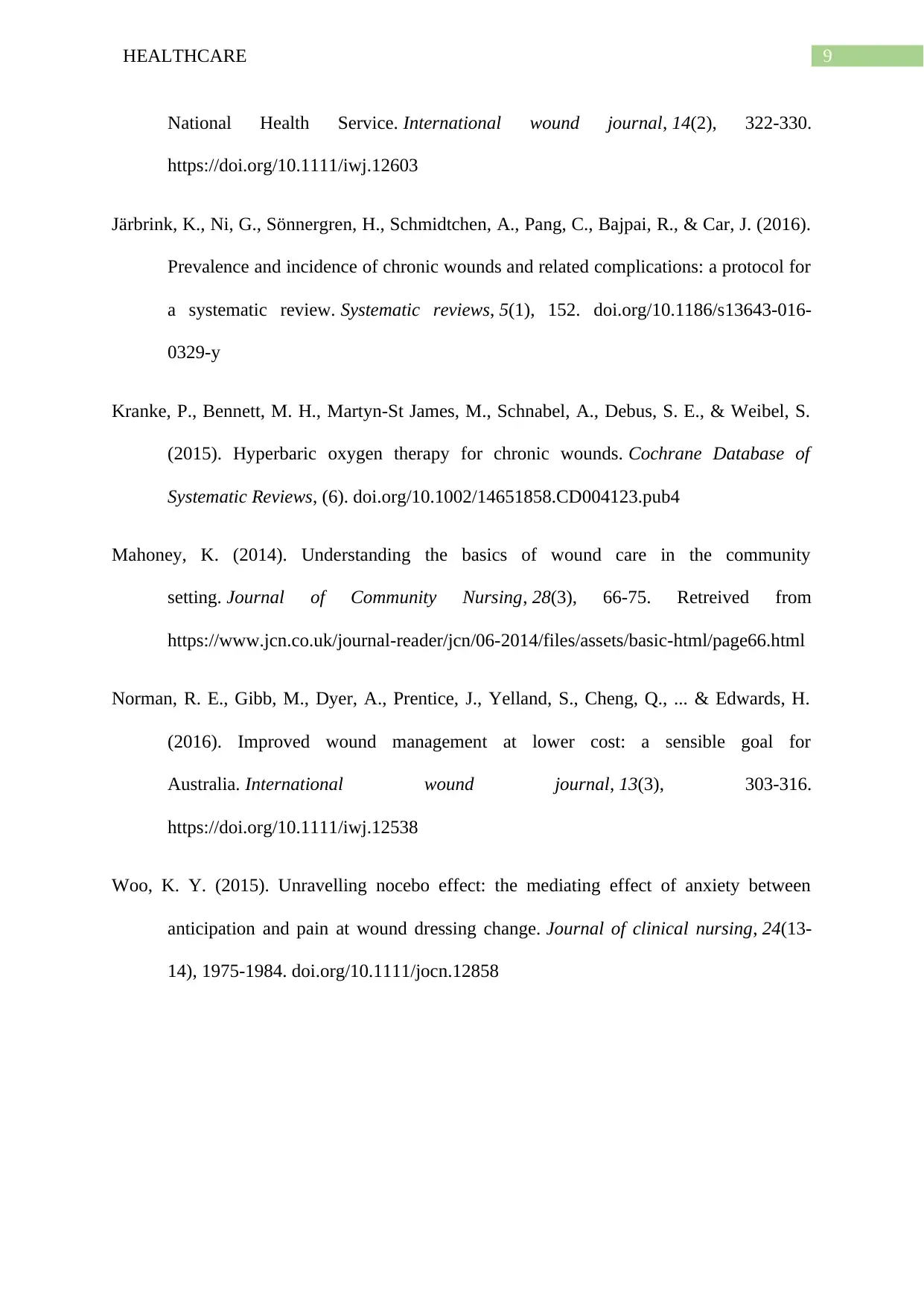
9HEALTHCARE
National Health Service. International wound journal, 14(2), 322-330.
https://doi.org/10.1111/iwj.12603
Järbrink, K., Ni, G., Sönnergren, H., Schmidtchen, A., Pang, C., Bajpai, R., & Car, J. (2016).
Prevalence and incidence of chronic wounds and related complications: a protocol for
a systematic review. Systematic reviews, 5(1), 152. doi.org/10.1186/s13643-016-
0329-y
Kranke, P., Bennett, M. H., Martyn‐St James, M., Schnabel, A., Debus, S. E., & Weibel, S.
(2015). Hyperbaric oxygen therapy for chronic wounds. Cochrane Database of
Systematic Reviews, (6). doi.org/10.1002/14651858.CD004123.pub4
Mahoney, K. (2014). Understanding the basics of wound care in the community
setting. Journal of Community Nursing, 28(3), 66-75. Retreived from
https://www.jcn.co.uk/journal-reader/jcn/06-2014/files/assets/basic-html/page66.html
Norman, R. E., Gibb, M., Dyer, A., Prentice, J., Yelland, S., Cheng, Q., ... & Edwards, H.
(2016). Improved wound management at lower cost: a sensible goal for
Australia. International wound journal, 13(3), 303-316.
https://doi.org/10.1111/iwj.12538
Woo, K. Y. (2015). Unravelling nocebo effect: the mediating effect of anxiety between
anticipation and pain at wound dressing change. Journal of clinical nursing, 24(13-
14), 1975-1984. doi.org/10.1111/jocn.12858
National Health Service. International wound journal, 14(2), 322-330.
https://doi.org/10.1111/iwj.12603
Järbrink, K., Ni, G., Sönnergren, H., Schmidtchen, A., Pang, C., Bajpai, R., & Car, J. (2016).
Prevalence and incidence of chronic wounds and related complications: a protocol for
a systematic review. Systematic reviews, 5(1), 152. doi.org/10.1186/s13643-016-
0329-y
Kranke, P., Bennett, M. H., Martyn‐St James, M., Schnabel, A., Debus, S. E., & Weibel, S.
(2015). Hyperbaric oxygen therapy for chronic wounds. Cochrane Database of
Systematic Reviews, (6). doi.org/10.1002/14651858.CD004123.pub4
Mahoney, K. (2014). Understanding the basics of wound care in the community
setting. Journal of Community Nursing, 28(3), 66-75. Retreived from
https://www.jcn.co.uk/journal-reader/jcn/06-2014/files/assets/basic-html/page66.html
Norman, R. E., Gibb, M., Dyer, A., Prentice, J., Yelland, S., Cheng, Q., ... & Edwards, H.
(2016). Improved wound management at lower cost: a sensible goal for
Australia. International wound journal, 13(3), 303-316.
https://doi.org/10.1111/iwj.12538
Woo, K. Y. (2015). Unravelling nocebo effect: the mediating effect of anxiety between
anticipation and pain at wound dressing change. Journal of clinical nursing, 24(13-
14), 1975-1984. doi.org/10.1111/jocn.12858
1 out of 10
Related Documents
Your All-in-One AI-Powered Toolkit for Academic Success.
+13062052269
info@desklib.com
Available 24*7 on WhatsApp / Email
![[object Object]](/_next/static/media/star-bottom.7253800d.svg)
Unlock your academic potential
Copyright © 2020–2025 A2Z Services. All Rights Reserved. Developed and managed by ZUCOL.





